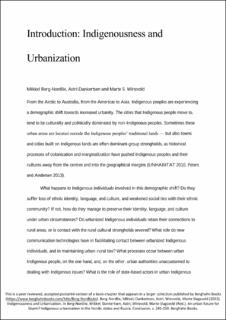| dc.description.abstract | From the Arctic to Australia, from the Americas to Asia, Indigenous peoples are experiencing a demographic shift towards increased urbanity. The cities that Indigenous people move to, tend to be culturally and politically dominated by non-Indigenous peoples. Sometimes these urban areas are located outside the Indigenous peoples’ traditional lands — but also towns and cities built on Indigenous lands are often dominant-group strongholds, as historical processes of colonization and marginalization have pushed Indigenous peoples and their cultures away from the centres and into the geographical margins (UNHABITAT 2010, Peters and Andersen 2013).What happens to Indigenous individuals involved in this demographic shift? Do they suffer loss of ethnic identity, language, and culture, and weakened social ties with their ethnic community? If not, how do they manage to preserve their identity, language, and culture under urban circumstances? Do urbanized Indigenous individuals retain their connections to rural areas, or is contact with the rural cultural strongholds severed? What role do new communication technologies have in facilitating contact between urbanized Indigenous individuals, and in maintaining urban–rural ties? What processes occur between urban Indigenous people, on the one hand, and, on the other, urban authorities unaccustomed to dealing with Indigenous issues? What is the role of state-based actors in urban Indigenous governance? How do Indigenous people organize to facilitate the survival of their culture and identity in urban settings? | en_US |
